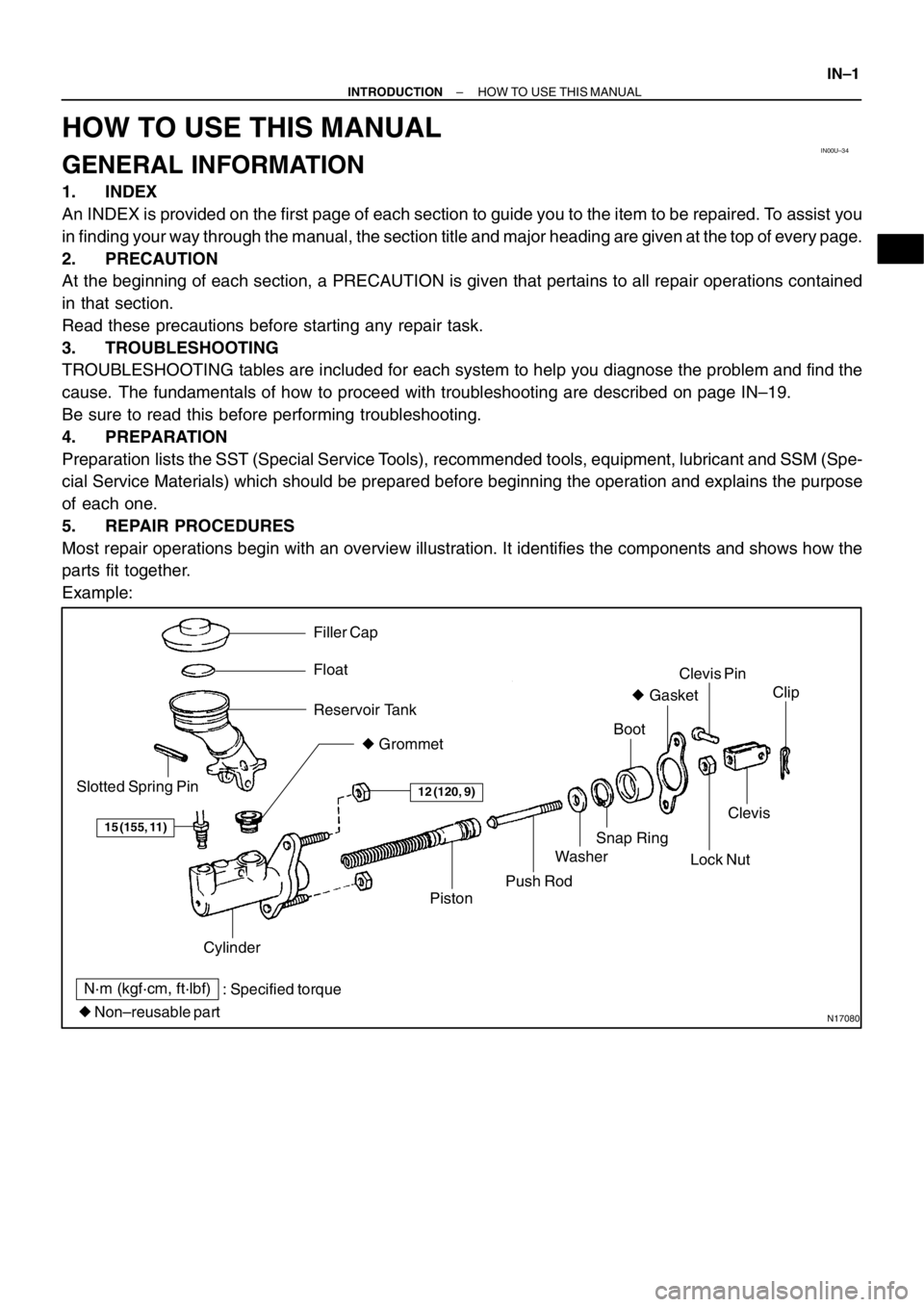Page 6 of 349

IN00U–34
N17080
Filler Cap
Float
Reservoir Tank
� Grommet
Clip
Slotted Spring Pin
: Specified torque
� Non–reusable partCylinder
Piston
Push Rod
Washer
Snap Ring
Boot
� Gasket
Lock Nut
Clevis Pin
Clevis
N·m (kgf·cm, ft·lbf)
12 (120, 9)
15 (155, 11)
– INTRODUCTIONHOW TO USE THIS MANUAL
IN–1
HOW TO USE THIS MANUAL
GENERAL INFORMATION
1. INDEX
An INDEX is provided on the first page of each section to guide you to the item to be repaired. To assist you
in finding your way through the manual, the section title and major heading are given at the top of every page.
2. PRECAUTION
At the beginning of each section, a PRECAUTION is given that pertains to all repair operations contained
in that section.
Read these precautions before starting any repair task.
3. TROUBLESHOOTING
TROUBLESHOOTING tables are included for each system to help you diagnose the problem and find the
cause. The fundamentals of how to proceed with troubleshooting are described on page IN–19.
Be sure to read this before performing troubleshooting.
4. PREPARATION
Preparation lists the SST (Special Service Tools), recommended tools, equipment, lubricant and SSM (Spe-
cial Service Materials) which should be prepared before beginning the operation and explains the purpose
of each one.
5. REPAIR PROCEDURES
Most repair operations begin with an overview illustration. It identifies the components and shows how the
parts fit together.
Example:
Page 7 of 349

Illustration:
what to do and where
21. CHECK PISTON STROKE OF OVERDRIVE BRAKE
(a)
Task heading : what to do
SST 09350–30020 (09350–06120)
Set part No. Component part No.
Detailed text : how to do task
(b)
Piston stroke: 1.40 � 1.70 mm (0.0551 � ������ ����
Specification
Place SST and a dial indicator onto the overdrive brake pis-
ton as shown in the illustration.
Measure the stroke applying and releasing the compressed
air (392 � ��� ���� � �kgf/cm
2 or 57 � 114 psi) as shown
in the illustration. IN–2
– INTRODUCTIONHOW TO USE THIS MANUAL
The procedures are presented in a step–by–step format:
�The illustration shows what to do and where to do it.
�The task heading tells what to do.
�The detailed text tells how to perform the task and gives other information such as specifications
and warnings.
Example�
This format provides the experienced technician with a FAST TRACK to the information needed. The upper
case task heading can be read at a glance when necessary, and the text below it provides detailed informa-
tion. Important specifications and warnings always stand out in bold type.
6. REFERENCES
References have been kept to a minimum. However, when they are required you are given the page to refer
to.
7. SPECIFICATIONS
Specifications are presented in bold type throughout the text where needed. You never have to leave the
procedure to look up your specifications. They are also found in Service Specifications section for quick ref-
erence.
8. CAUTIONS, NOTICES, HINTS:
�CAUTIONS are presented in bold type, and indicate there is a possibility of injury to you or other
people.
�NOTICES are also presented in bold type, and indicate the possibility of damage to the components
being repaired.
�HINTS are separated from the text but do not appear in bold. They provide additional information to
help you perform the repair efficiently.
9. SI UNIT
The UNITS given in this manual are primarily expressed according to the SI UNIT (International System of
Unit), and alternately expressed in the metric system and in the English System.
Example:
Torque: 30 N·m (310 kgf·cm, 22 ft·lbf)
Page 10 of 349

BE1367
Medium Current Fuse and High Current Fuse
Equal Amperage Rating
V00076
Abbreviation Part Name Symbol Illustration
FUSE
MEDIUM CURRENT FUSE
HIGH CURRENT FUSE
FUSIBLE LINK
CIRCUIT BREAKERFUSE
M–FUSE
H–FUSE
FL
CB
– INTRODUCTIONREPAIR INSTRUCTIONS
IN–5
(h) Carefully observe all specifications for bolt tightening
torques. Always use a torque wrench.
(i) Use of special service tools (SST) and special service ma-
terials (SSM) may be required, depending on the nature
of the repair. Be sure to use SST and SSM where speci-
fied and follow the proper work procedure. A list of SST
and SSM can be found in Preparation section in this
manual.
(j) When replacing fuses, be sure the new fuse has the cor-
rect amperage rating. DO NOT exceed the rating or use
one with a lower rating.
(k) Care must be taken when jacking up and supporting the
vehicle. Be sure to lift and support the vehicle at the prop-
er locations (See page IN–7).
(1) If the vehicle is to be jacked up only at the front or
rear end, make sure to place the stopper under the
wheels at the opposite end to block them in order to
ensure safety.
Page 22 of 349

B07465
New
Previous
– INTRODUCTIONFOR ALL OF VEHICLES
IN–17
5. FOR VEHICLES EQUIPPED WITH POWER WINDOW CONTROL SYSTEM
When the battery is disconnected or the power to the window regulator motor is cut, the power window con-
trol system does not operate. It is necessary to initialize the system in the following procedures. Otherwise
window cannot be operated normally.
(1) Close window to the highest position.
(2) Keep holding the switch for 5 seconds.
(3) Check that automatic operation works. If not, repeat the above procedures.
6. FOR VEHICLES EQUIPPED WITH SLIDING ROOF SYSTEM
Sliding roof stop position might be required to be initialized when battery failures (such as battery disconnec-
tion, connector disconnection and the voltage drop) are detected while the system is in operation. This also
occurs when rotating the motor with the battery disconnected. Sliding roof initialization can be done by the
following procedures.
(1) Operate the roof up to the maximum tilt position.
(2) Release the switch, and push it again in the same direction. (After 10 seconds have elapsed,
initialization begins.)
(3) The roof starts automatic operation if holding the switch, completes full one cycle (tilt down, slide
open, slide close and tilt up) of travel. Do not release the switch until the roof stops.
(4) Check that the roof stops at the correct position.
7. FOR VEHICLES EQUIPPED WITH BRAKE PIPE FIT-
TING OF NEW STANDARD
A flare shape of a new standard is used for the brake pipe fitting
from this changed models.
NOTICE:
�When ordering or replacing the parts, please be sure
to check and use the fitting of the same flare type.
�Do not over–tighten them more than the standard
torque.
Torque: 15 N·m (155 kgf·cm, 11 ft·lbf)
Page 47 of 349
PP0VD–02
– PREPARATIONMANUAL TRANSAXLE (E251)
PP–3
RECOMMENDED TOOLS
09025–00010Torque Wrench (30 kgf–cm)Differential preload
09031–00030Pin Punch .
09040–00011Hexagon Wrench Set .
09042–00040Torx Socket T50 .
09042–00050Torx Socket T45 .
09082–00040TOYOTA Electrical Tester.
09258–00030Hose Plug Set .
09905–00012Snap Ring No.1 Expander .
09905–00013Snap Ring Pliers .
Page 48 of 349
PP0VE–02
PP–4
– PREPARATIONMANUAL TRANSAXLE (E251)
EQUIPMENT
Dial indicator with magnetic base
Feeler gauge
Magnetic finger
Micrometer
Plastigage
Precision straight edge
Torque wrench
Vise
Page 53 of 349
PP11I–02
– PREPARATIONSUSPENSION AND AXLE
PP–9
EQUIPMENT
Torque wrench
Page 55 of 349
PP27W–01
– PREPARATIONBRAKE
PP–11
BRAKE
EQUIPMENT
Torque wrench
MicrometerBlade